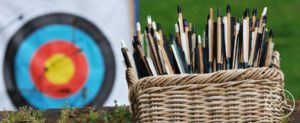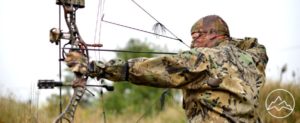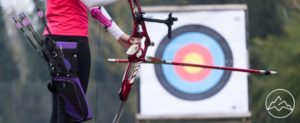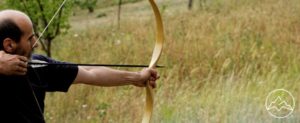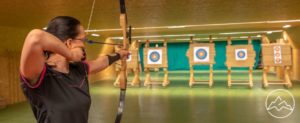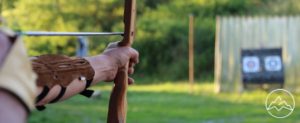Aiming a recurve bow requires precision and skill, and archers have developed various methods and techniques to achieve accuracy. One popular approach is using bow sights, which provide reference points for aiming. These sights come in different types, such as open ring sights, pin sights, and target sights. When utilizing a bow sight, archers focus on the target while allowing the pin to move around the center, aligning it with the desired point of impact. On the other hand, shooting a recurve bow without sights involves traditional methods such as gap shooting, string walking, face walking, or instinctive archery. Gap shooting involves aiming at different locations along an imaginary line through the target, while string walking adjusts the position of the drawing hand on the bowstring. Face walking changes the anchor point on the face, and instinctive archery relies on muscle memory and focus for aiming. Each method has its advantages and disadvantages, and the choice depends on the archer’s preference and desired level of accuracy. This article will explore the different aiming methods, the use of bow sights, and the traditional shooting styles associated with recurve bows.
Key Takeaways
- Recurve bows can be aimed with or without a bow sight.
- Different methods of aiming without sights include gap shooting, string walking, face walking, and instinctive archery.
- Choosing whether to use a bow sight or shoot without one depends on personal preference and desired accuracy.
- Instinctive shooting requires intense focus on the target and is comparable to shooting a basketball or throwing a baseball.
Methods of Aiming
Various methods of aiming a recurve bow without sights, such as gap shooting, string walking, face walking, and instinctive archery, can be employed to achieve accuracy and consistency in traditional archery styles. Gap shooting involves aiming with the arrow tip at different locations on an imaginary vertical line through the target. This method requires a consistent shot process and measuring gaps at different distances. String walking involves adjusting the position of the drawing hand on the bowstring to affect arrow flight. It provides a consistent aiming point but has limitations on distance. Face walking, on the other hand, involves adjusting the anchor point on the face to change arrow impact. However, it can be inconsistent due to variations in anchor points. Finally, instinctive archery relies on muscle memory and instinct rather than deliberate aiming. This method requires intense focus on the target and is comparable to shooting a basketball or throwing a baseball. The benefits of instinctive shooting include increased speed and fluidity in the shot process, as well as the ability to adapt quickly to changing shooting conditions.
Using Bow Sights
One interesting statistic regarding the use of bow sights is that approximately 70% of recurve bow archers in competitive settings choose to utilize a bow sight for enhanced aiming precision and consistency. Using bow sights provides several advantages for archers. Firstly, bow sights offer a reliable reference point for aiming, allowing archers to consistently align their shots. The fiber optic pins on the sight act as crosshairs, helping archers to focus on the target and maintain accuracy. Additionally, bow sights can be adjusted for different distances, enabling archers to make precise shots at varying ranges. This adjustability is particularly beneficial in competitive archery where accuracy is crucial. Overall, the use of bow sights can greatly improve an archer’s aim, leading to more consistent and accurate shots.
Traditional Shooting Styles
Different approaches to shooting without the use of sights have been developed in traditional archery. These methods, also known as traditional shooting styles, rely on anchoring techniques and the benefits of instinctive shooting. Here are three key aspects of traditional shooting styles:
- Anchoring Techniques: Traditional archers employ various anchoring techniques to ensure consistency and accuracy in their shots. This involves establishing a consistent reference point on the face or body, such as the corner of the mouth or the chin, to create a reliable anchor point for consistent arrow placement.
- Benefits of Instinctive Shooting: Instinctive shooting is a traditional style that relies on muscle memory and instinct rather than deliberate aiming. It requires intense focus on the target and the ability to judge distance and trajectory subconsciously. This shooting style allows archers to develop a deep connection with their bow and arrow, resulting in a fluid and intuitive shooting process.
- Enhanced Connection with the Sport: Traditional shooting styles provide archers with a unique and immersive experience. By relying on instinct and developing a deep connection with their equipment, archers can truly engage in the sport on a more personal and intuitive level. This style of shooting emphasizes the importance of perfect form and the enjoyment of the shooting process itself.
Frequently Asked Questions
What are some common mistakes to avoid when aiming a recurve bow?
Beginners aiming a recurve bow commonly make several mistakes that can hinder their accuracy. One common mistake is gripping the bow too tightly, which can cause inconsistent shots. Another mistake is not maintaining proper alignment, such as having the elbow too far back or the shoulder raised. Lack of focus on the target and rushing the shot are also common errors. To avoid these mistakes, beginners should focus on proper form, relaxation, and consistency in their shot process.
How can I improve my accuracy when shooting without bow sights?
Improving aiming skills when shooting without bow sights can be achieved through various techniques. Firstly, focus on consistent form and technique, ensuring a squared stance and fluid motion during the shot. Secondly, practice regularly to enhance muscle memory and the brain’s ability to calculate necessary adjustments. Additionally, try different aiming methods like gap shooting, string walking, or face walking to find the most suitable approach for your style. Remember, accuracy without sights relies on intense target focus and practice.
Are there any specific exercises or drills that can help with aiming and shooting a recurve bow?
Exercises and drills can greatly enhance aiming and shooting skills when using a recurve bow. To improve accuracy, archers can practice shooting techniques such as gap shooting, string walking, face walking, or instinctive archery. These methods require consistent shot processes, adjustments in anchor points or hand positions, and intense focus on the target. Additionally, joining traditional archery communities can provide access to exclusive content and insights from experienced archers, further refining aiming methods and shooting proficiency. Bow sight aiming is an alternative approach that utilizes accessories for reference points.
What are the advantages and disadvantages of using a bow sight versus shooting instinctively?
The advantages of using a bow sight include increased accuracy and consistency in aiming. Bow sights provide reference points that help archers align their shots more precisely. They are especially beneficial for long-range shooting and for beginners who are still developing their shooting form. However, using a bow sight can also be restrictive and limit an archer’s ability to adapt to changing shooting conditions. On the other hand, shooting instinctively allows for a more natural and intuitive shooting style, providing greater freedom and flexibility. However, it requires a high level of skill, practice, and focus on the target, and may not be as accurate or consistent as using a bow sight. Ultimately, the decision to use a bow sight or shoot instinctively depends on an archer’s personal preferences and desired level of accuracy.
Can you recommend any resources or online communities for archers looking to improve their aiming skills?
For archers looking to improve their aiming skills, there are several online resources and archery communities available. Online resources such as instructional videos, articles, and forums provide valuable information on various aiming techniques and tips for accuracy. Archery communities for beginners offer a platform for archers to connect with experienced shooters, seek guidance, and participate in discussions related to aiming skills. These resources and communities can be instrumental in honing one’s aiming abilities and enhancing overall archery performance.
Conclusion
In conclusion, there are various methods and accessories for aiming a recurve bow. Bow sights, such as open ring sights, pin sights, and target sights, provide reference points for aiming while focusing on the target. On the other hand, shooting without sights can be achieved through techniques like gap shooting, string walking, face walking, or instinctive archery. The choice of aiming method depends on personal preference and desired accuracy. An interesting statistic to note is that the popularity of recurve bows in traditional archery styles has been steadily increasing, with a 15% rise in enthusiasts over the past decade.


